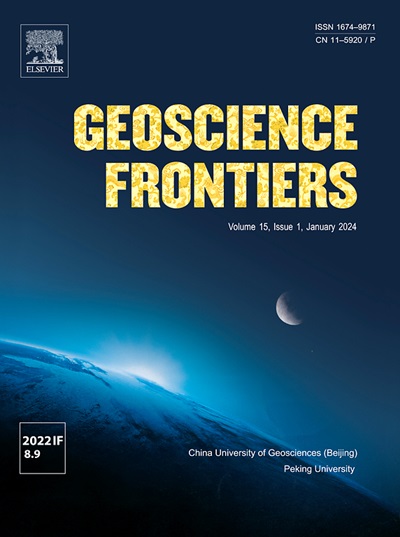前寒武纪扁平俯冲期间的长英质岩浆活动
IF 8.9
1区 地球科学
Q1 GEOSCIENCES, MULTIDISCIPLINARY
引用次数: 0
摘要
现代地壳主要保存在大陆上,这标志着早期地球的重大转变,当时海洋地壳占主导地位。大陆地壳主要由长英质岩石组成,大约在40亿年前的太古宙开始生长。这些长英质岩石的起源以及大陆地壳形成背后的机制仍然存在争议,太古宙的构造体系与之形成了鲜明的对比。我们的新数值模拟表明,在与早期地球相对应的地幔位势温度升高(比现在高150-200°C)的洋内板块收敛过程中,俯冲和大量长英质岩浆活动(深部和相关的火山)形成了覆盖在海洋板块之上的薄长英质地壳。这与现代深陡俯冲形成鲜明对比,现代深陡俯冲导致玄武岩和长英质岩浆的生成明显减少。进一步的模拟表明,在随后包含薄长英质域的海洋地壳的平俯冲过程中,这些浮力地壳段与浅板块部分分离。它们像底辟岩一样通过蛇纹状的地幔楔体上升,从而在板块上部的海洋地壳中形成了一个厚厚的大陆地壳核。长英质熔体和岩石通过地幔楔块的模拟迁移与前寒武纪sanukitoids的存在一致,并在一定程度上与闪长岩-闪长岩-花岗闪长岩(TTG)组中Mg、Ni和Cr的富集一致。因此,我们认为浅层前寒武纪俯冲作用可能对地球早期大陆地壳的形成和再循环起着重要作用。本文章由计算机程序翻译,如有差异,请以英文原文为准。

Felsic magmatism during Precambrian flat subduction
The modern Earth’s crust is predominantly preserved in continents, marking a significant shift from early Earth when oceanic crust was far more dominant. The growth of continental crust, composed largely of felsic rocks, began ∼4 billion years ago in the Archean eon. The origins of these felsic rocks and thus the mechanism behind continental crust formation remains debatable, with contrasting tectonic regimes proposed for the Archean. Our new numerical modeling of intraoceanic plate convergence at elevated mantle potential temperatures (150‒200 °C higher than present day) corresponding to the early Earth shows a shallow-dipping (flat) regime of subduction and voluminous felsic magmatism (plutonic and related volcanic) forming a thin felsic crust on top of the overriding oceanic plate. This is in strong contrast to the modern deep and steep subduction regime, which results in notably less generation of both basaltic and felsic magmas. Further modeling shows that during subsequent flat subduction of oceanic crust containing thin felsic domains, these buoyant crustal segments detach from the shallow slab portions. They rise as diapirs through the serpentinised mantle wedge, thereby forming a thick nucleus of continental crust within the oceanic crust of the upper plate. The modeled migration of felsic melts and rocks through the mantle wedge is in agreement with the presence of Precambrian sanukitoids and to some extent by Mg, Ni, and Cr enrichment in rocks from tonalite-trondhjemite-granodiorite (TTG) suites. Therefore, we conclude that shallow Precambrian subduction likely contributed notably to the formation and recycling of continental crust in Earth’s early history.
求助全文
通过发布文献求助,成功后即可免费获取论文全文。
去求助
来源期刊

Geoscience frontiers
Earth and Planetary Sciences-General Earth and Planetary Sciences
CiteScore
17.80
自引率
3.40%
发文量
147
审稿时长
35 days
期刊介绍:
Geoscience Frontiers (GSF) is the Journal of China University of Geosciences (Beijing) and Peking University. It publishes peer-reviewed research articles and reviews in interdisciplinary fields of Earth and Planetary Sciences. GSF covers various research areas including petrology and geochemistry, lithospheric architecture and mantle dynamics, global tectonics, economic geology and fuel exploration, geophysics, stratigraphy and paleontology, environmental and engineering geology, astrogeology, and the nexus of resources-energy-emissions-climate under Sustainable Development Goals. The journal aims to bridge innovative, provocative, and challenging concepts and models in these fields, providing insights on correlations and evolution.
 求助内容:
求助内容: 应助结果提醒方式:
应助结果提醒方式:


